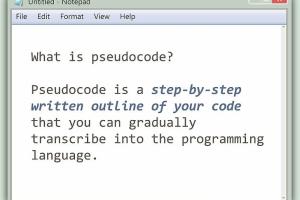Learn to Write Pseudocode: What It Is and Why You Need It

-
Quick Links:
- What is Pseudocode?
- Importance of Pseudocode
- How to Write Pseudocode
- Examples of Pseudocode
- Best Practices for Writing Pseudocode
- Common Mistakes in Pseudocode
- Case Studies: Pseudocode in Action
- Expert Insights on Pseudocode
- FAQs
What is Pseudocode?
Pseudocode is a simplified, informal way of describing a computer program's logic. It uses a mix of natural language and programming language syntax but avoids the strict rules of syntax found in actual programming languages. By focusing on the logic, pseudocode allows programmers to outline their thoughts without getting bogged down in syntax errors.
Importance of Pseudocode
Pseudocode serves as a bridge between human thinking and machine logic. Here are some key reasons why pseudocode is essential:
- Clarity: It helps clarify your thoughts and structure before diving into the complexity of code.
- Language-Agnostic: It allows you to focus on the algorithm rather than the language-specific syntax.
- Collaboration: It enables non-programmers to understand the logic behind the code.
How to Write Pseudocode
Writing pseudocode involves following some simple guidelines:
- Start with a Problem Statement: Clearly define what problem you are trying to solve.
- Break it Down: Decompose the problem into smaller, manageable parts.
- Use Simple Language: Write in plain English, using straightforward terms that convey your logic.
- Be Consistent: Use consistent terminology and formatting throughout.
Examples of Pseudocode
Here are several examples of pseudocode to illustrate its application:
1. Finding the maximum number in an array:
SET max TO array[0]
FOR each number IN array
IF number > max THEN
SET max TO number
END IF
END FOR
RETURN max
2. A simple login function:
FUNCTION login(username, password)
IF username IS valid AND password IS correct THEN
RETURN "Login Successful"
ELSE
RETURN "Login Failed"
END IF
END FUNCTION
Best Practices for Writing Pseudocode
To ensure your pseudocode is effective, consider these best practices:
- Use indentation to show structure and hierarchy.
- Keep it concise and to the point.
- Use comments to explain complex logic.
- Review and revise your pseudocode for clarity.
Common Mistakes in Pseudocode
Even experienced programmers can make mistakes when writing pseudocode. Here are some common pitfalls to avoid:
- Overcomplicating: Avoid using too much technical jargon or complex syntax.
- Lack of Structure: Ensure that your pseudocode is well organized and easy to follow.
- Skipping Steps: Make sure to include all necessary steps in your logic.
Case Studies: Pseudocode in Action
Let’s take a look at a few case studies where pseudocode played a crucial role:
Case Study 1: E-Commerce Checkout System
A leading e-commerce platform used pseudocode to streamline their checkout process, allowing their development team to visualize user flows and eliminate bottlenecks before coding.
Case Study 2: Mobile App Development
A mobile app startup used pseudocode to design the logic for its user authentication system, enabling faster prototyping and testing of user experiences.
Expert Insights on Pseudocode
We reached out to several software development experts for their opinions on pseudocode:
"Pseudocode is a game-changer for collaborative projects. It allows team members from different backgrounds to contribute effectively." - Jane Doe, Software Engineer
"It streamlines the coding process by clarifying logic upfront, ultimately saving time and reducing errors." - John Smith, Senior Developer
FAQs
1. What is the main purpose of pseudocode?
The main purpose of pseudocode is to outline the logic of a program in a language-agnostic format that is easy to understand.
2. Can pseudocode be run on a computer?
No, pseudocode is not executable code; it is meant for planning and documentation purposes only.
3. How detailed should my pseudocode be?
Pseudocode should be detailed enough to convey the logic clearly but concise enough to remain readable.
4. Is there a standard format for writing pseudocode?
No, there is no universal standard; different organizations may adopt their own conventions.
5. Can beginners learn programming through pseudocode?
Yes, pseudocode is an excellent tool for beginners to grasp programming logic without needing to understand specific syntax.
6. What programming languages are pseudocode compatible with?
Pseudocode can be adapted to any programming language, as it focuses on logic rather than syntax.
7. How does pseudocode help in debugging?
By outlining logic step-by-step, pseudocode can help identify logical errors before coding begins.
8. Can pseudocode be used for algorithms?
Absolutely! Pseudocode is often used to describe algorithms in a clear and understandable way.
9. Is pseudocode used in professional software development?
Yes, many professionals use pseudocode during the planning phase of software development to communicate ideas effectively.
10. What are some tools for writing pseudocode?
While pseudocode doesn't require special tools, many programmers use text editors or diagramming tools to create their pseudocode.
Random Reads
- Why am i not getting notifications
- How to wipe a computer
- How to wipe a mac clean
- Mastering pc power supply issues
- How to turn on ringer iphone
- How to unpartition a hard drive
- How to make money on adopt me roblox
- How to type pi symbol
- Ultimate guide to whiten grout
- Quickly change color background photoshop